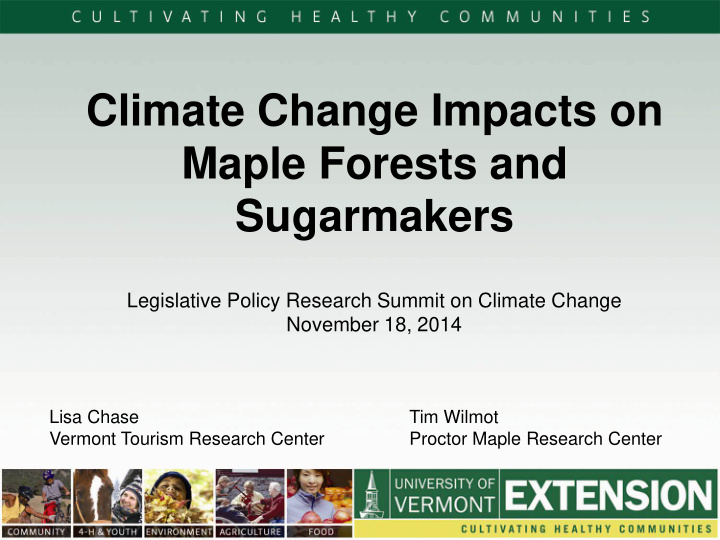



Climate Change Impacts on Maple Forests and Sugarmakers Legislative Policy Research Summit on Climate Change November 18, 2014 Lisa Chase Tim Wilmot Vermont Tourism Research Center Proctor Maple Research Center
Maple Contributes to… Environment Culture Economy
United States Maple Production, 2014 Gallons and Percent by State Source: USDA NASS
Syrup Production over Time • Production has been driven by demand and aided by technology but weather plays a role (2012) Source: Proctor Maple Research Center
Change in Tapping Season
Forest Health • Expansion of invasive plants Japanese barberry in a sugarbush Oriental bittersweet
Forest Health • Stressed maple trees are more susceptible to insects and disease • Monocultures are especially hard hit Sugar Maple Borer
Syrup Quality • Microorganism growth • Syrup quality may suffer, less table grade and more commercial and substandard
Adaptability of Sugarmakers
Findings from Interviews • Some are concerned with climate change impacts in the future • Tremendous diversity within the maple production industry: – Annual maple production – Products and services offered – Technology used – Business management in general
Mail Survey of Sugarmakers
Mail Survey Underway • Mail survey of Northern Forest regions of Vermont and New York • 1052 sugarmakers in VT and 270 in NY • Caledonia, Essex, Franklin, Lamoille, Orleans and Washington Counties of VT • Adirondack Park in New York • October – November 2014
Model of Adaptability Research funded by the Northeastern States Research Cooperative
Next Steps • Survey data will quantify perceptions and generate business adaptability scales: – Management – Customer base – Technology • Identify significant facilitators and barriers • Focus group will develop strategies to plan for and adapt to climate change
Acknowledgments • Collaboration with SUNY College of Environmental Science and Forestry (SUNY ESF), the NYS Maple Producers Association, and the Vermont Maple Sugar Makers’ Association • Funding provided by the Northeastern States Research Cooperative
Recommend
More recommend